TS
boleroes11
Awareness saving the lives of crews of vehicles
Situational Awareness: saving the lives of crews of vehicles
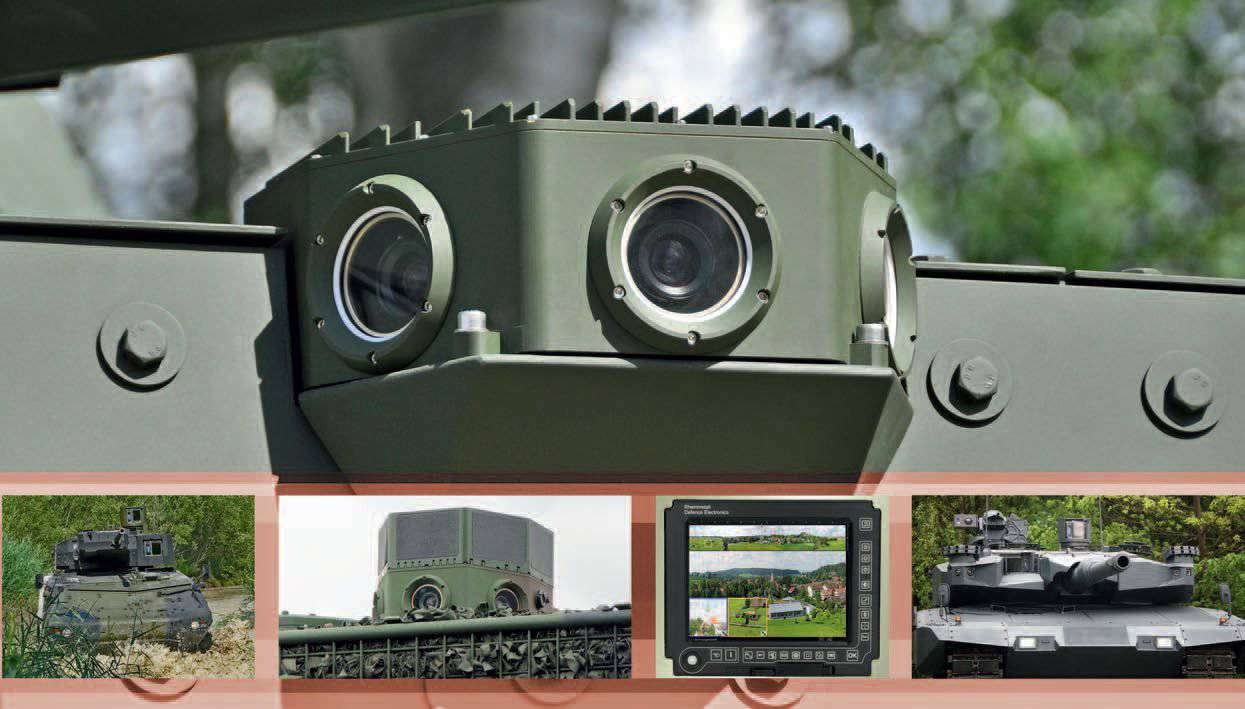
SAS module on board the machine. System from Rheinmetall can have an
automatic target recognition
Ballistic threats, mines and roadside bombs faced by Western troops during the recent operations in Iraq and Afghanistan led to the adoption of machines and weapons systems that allow personnel to stay safe inside the armored capsule. On the one hand it ensures better protection, on the other degrades situational awareness (situational awareness of diverse information in a single space-time volume) crew. Something similar has already experienced soldiers of the infantry units.
The need to maintain or improve the level of situational awareness becomes even more important as the number of tasks performed in the urban environment, where the infantry is necessary to understand the situation before starting or feed ramp door. In this regard, many companies have developed optical-electronic systems that allow crews to get the maximum amount of visual information under the protection of armor. Can also be added to other sensory components such as system definition shots that not only warn personnel that their machine is under the gun, but also inform them about the direction and distance from which the shot occurred. Basically, situational awareness system trying to give crews that they could see and hear, if kept outside the machine head with the added benefit that can give advanced sensors.
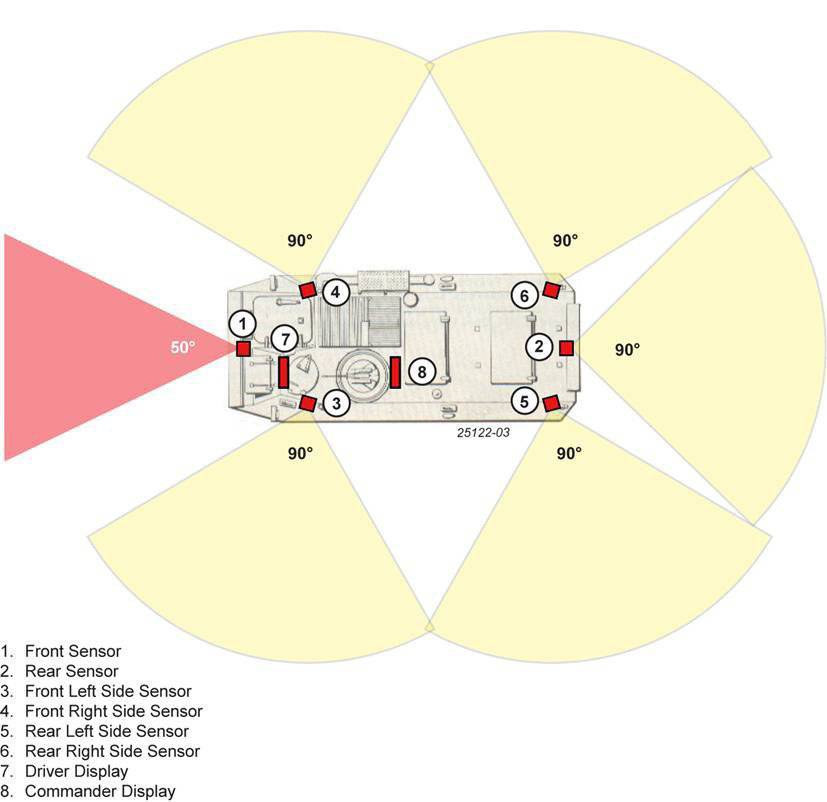
the possible deployment of sensors Selex Galileo Road Marshall, including night view of the driver 50 °
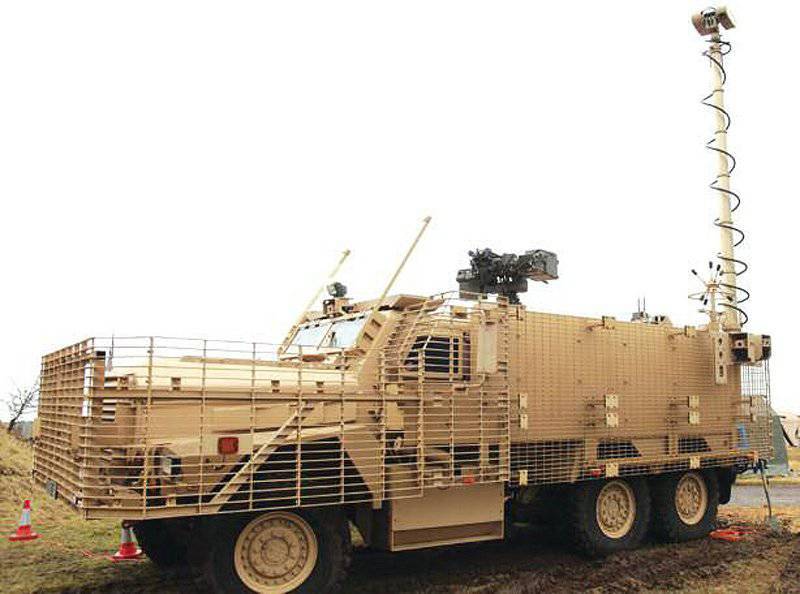 Situational Awareness: saving the lives of crews of vehicles
Situational Awareness: saving the lives of crews of vehicles
Machine Mastiff British army equipped with a system Selex Galileo Road Marshall. The company has delivered more than 1,200 systems to the British Ministry of Defence
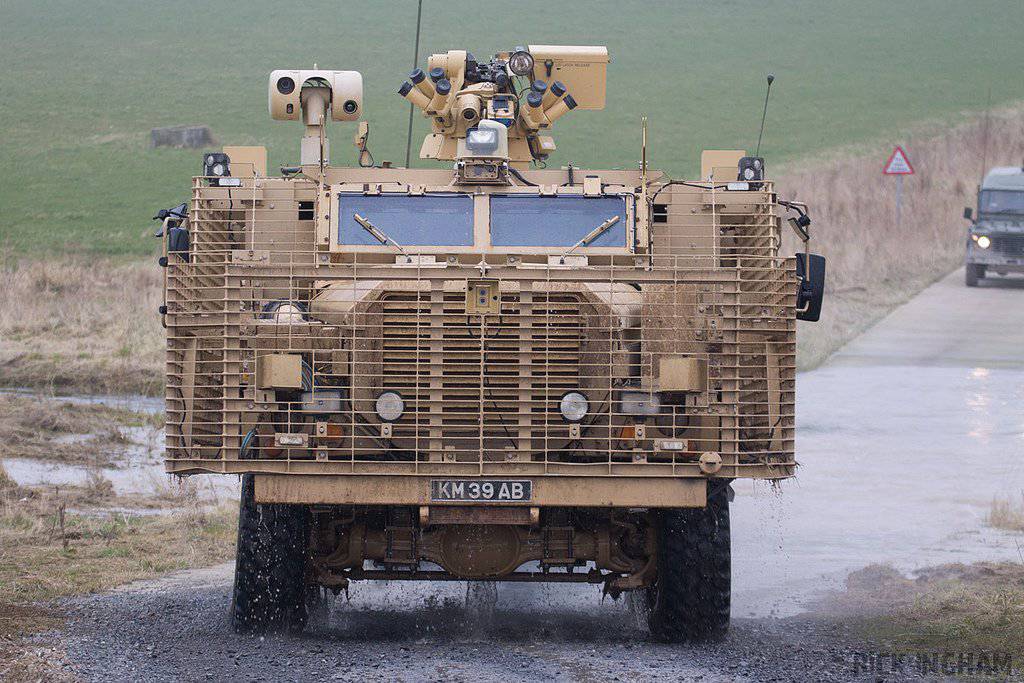
Optoelectronic 360 °
Round visibility is the first parameter good review system of the vehicle, which itself depends on the network, collecting data and sending them to a processor, which in turn produces the image on the screens of the crew. Most of the widely accepted decisions based on a set of sensors placed around the car or around the chassis if the machine has a tower. Single sensors Omnidirection 360 ° also available in the market, they can be cheaper and easier to install. The problem consists in that quite often block the view of the machine elements, while odnosensornye systems have redundancy.
Company Selex Galileo has developed an integrated set of situational awareness for vehicle called Road Marshall, which includes a family of hardware, ranging from near-awareness and environment awareness far RSTA (recconnaissance, surveillance and target acquisition - intelligence, surveillance and target acquisition). The system - multi-function display, which is not only display, but also brings power to all connected systems and provides a link.
The standard model has a 10.4-inch display with a resolution of 1024x768 pixels, although the version with built-in computer with Windows XP is also available for third-party applications. These displays have a picture-in-picture mode, which is not available for smaller displays 8.4 inch crew. All sensors are connected to a single quick-release unit. For applications near surveillance company Selex Galileo uses its modules Night Vision System Driver (Driver Night Vision System), representing an uncooled thermal imager with a field of view of 52 ° x 38 °, working in the range of 8 - 12 microns. They can be supplemented with a day / night camera with a field of view of 90 ° x 75 ° and sensitivity from 0.009 to 100 lux. Configurations may vary from the driver's seat with a thermal camera and a screen to the system with a full circular cover 360 °; This system is able to handle up to 16 cameras. Each screen is an independent, soldiers can cause a desired image from one of the cameras. The company delivered more than 1,200 systems British Ministry of Defence. All protected Mastiff machine equipped with a 360 ° angle and have three screens: the driver, commander and assault.
The exhibition DSEI 2013 company Selex Galileo unveiled its new digital two-channel thermal / color camera DNVS-4 having two fields of view, respectively, 52 ° x 39 ° and 62 ° x 46,5 °. The output signal is a color video format (or Def Stan 00-82, or GigE Vision). The camera module can be added to cleaning windows. It is available only as a color or day / night camera with high performance, either as a monochrome camera for low light conditions. While previous analog version currently stands in service in Australasia, Europe and the Middle East, including Saudi Arabia, where it is installed on the BMP, the newest digital version has received an order from an unnamed European NATO member country. System Road Marshall from Selex Galileo has been integrated with the sound-detecting means firing positions: Britain chose Raytheon BBN Boomerang III, and other buyers system O1dB Metravib Pilar.
Over the past few years, Thales UK has put the UK around 100 analog systems situational awareness, but fully digital SI system was introduced in early 2011. Known under the designation of ILSA (Integrated Local Situational Awareness - integrated local situational awareness), the system includes a digital network with open architecture, as well as opto-electronic sensors and displays. However, the system is able to accept any sensor or display that is compatible with the new British design standards Def Stan 00-82 Digital Video Distribution and Def Stan 23-09 Generic Vehicle Architecture (GVA). The first contract was immediately obtained from the Force Protection Europe, on which the company Thales UK is responsible for all the electronic architecture Foxhound (armored vehicle under the trademark Ocelot, selected as part of the British requirements for light protected patrol car).
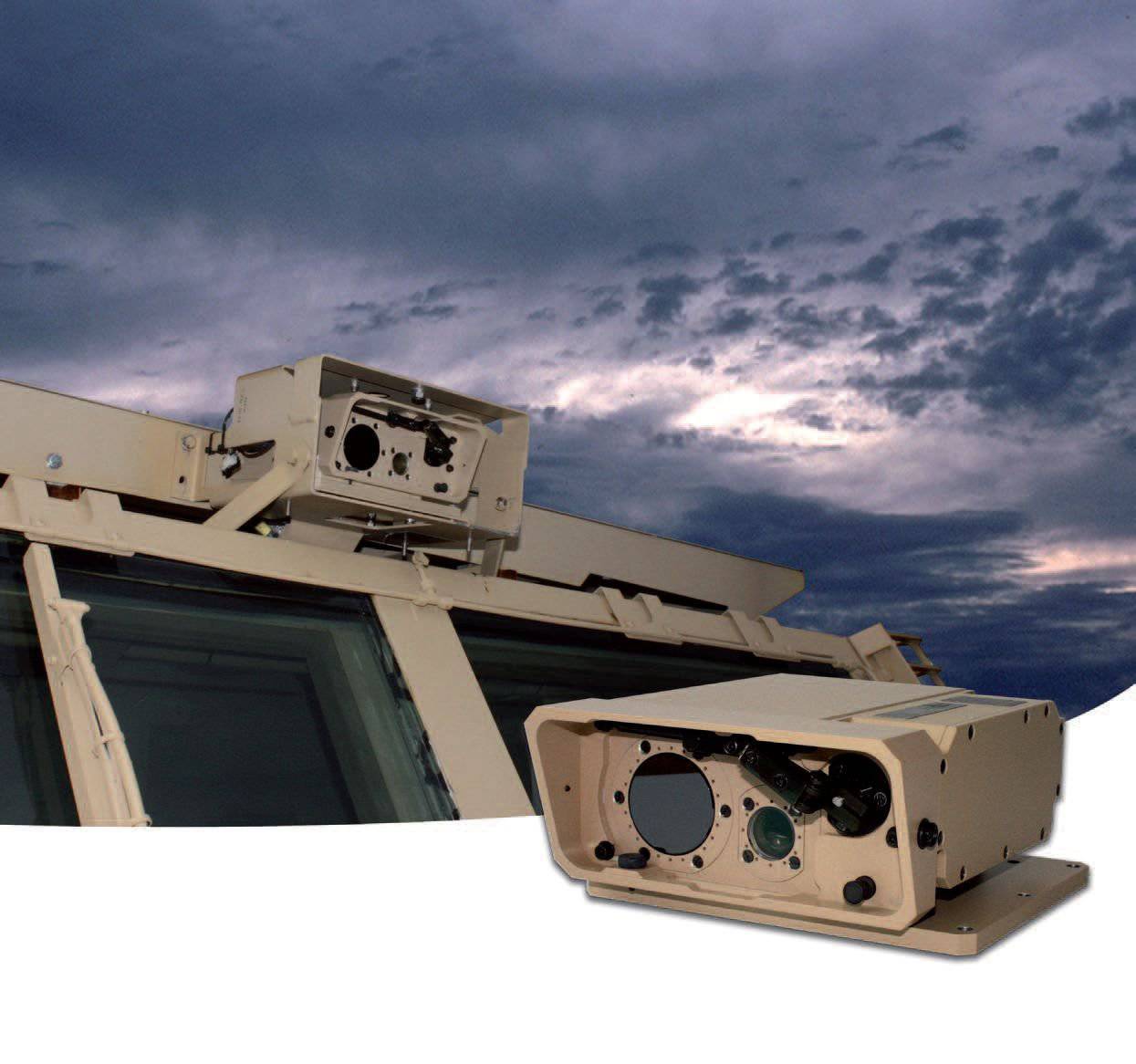
One of the newest products Selex Galileo - two-channel thermal / color camera DNVS-4
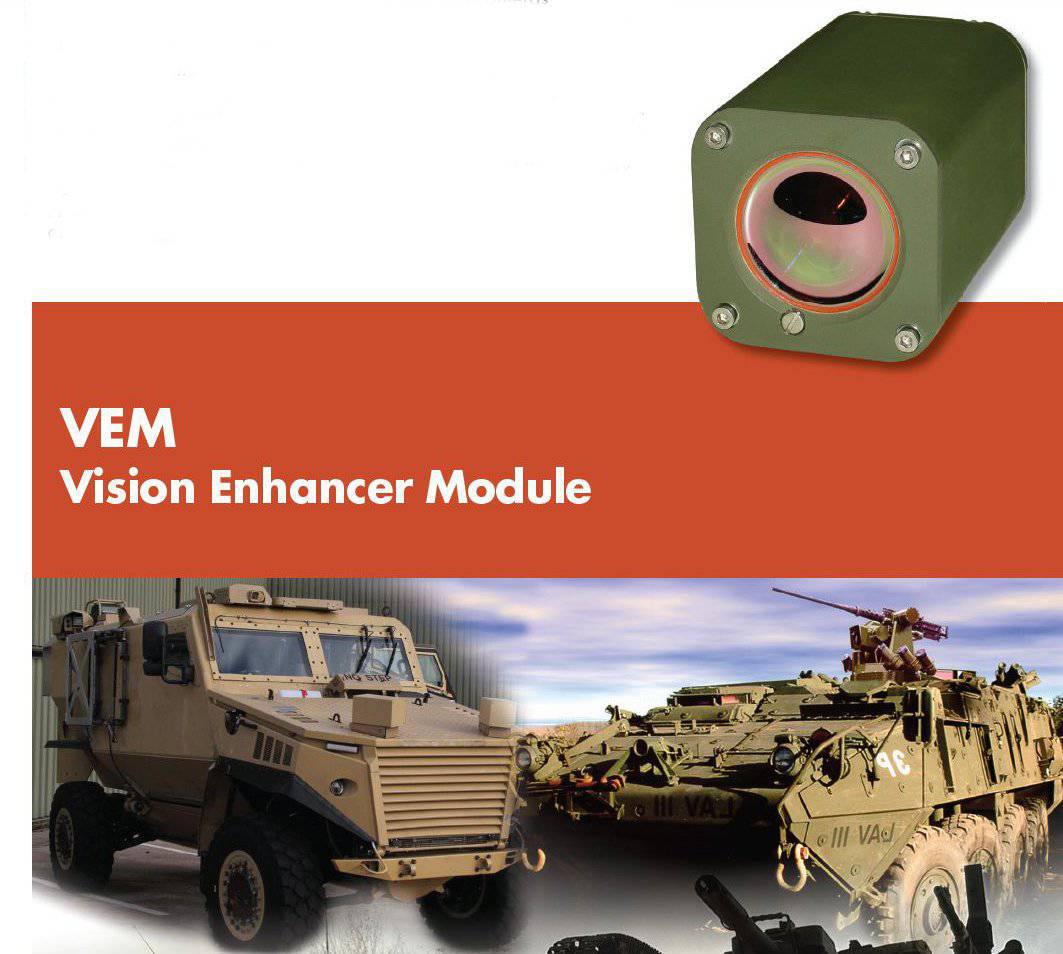
Thales VEM-2 RHS - this thermal sensor system ILSA, available with different fields of view
Thus, in early 2011, were ordered about 200 systems. ILSA ensures minimum latency and consists of two types of sensors, thermal cameras VEM-2 (W) and color / monochrome cameras, both small size weighing less than 2.5 kg. Thermal imaging cameras are in the range of 8 - 12 microns, have a horizontal field of view of 40 °, 50 ° and 90 ° and are based on the detector with a matrix of 640 x 480 pixels. The cameras have a horizontal field of view of 78 ° or 96 °, and can operate in low light down to 0.1 lux with 480 lines in color mode and 600 lines in monochrome mode, the sensor guarantees recognition of rights in the 100 meters. Images are sent to the central node, which distributes them to different displays "on demand", thus allowing, driver, commander and arrow, and a landing on their screens to see related images. ILSA system can accept other types of digital and analog sensors, for example, existing sights, remotely controlled weapon stations, speakers determine shot, even though the company has not asked for their integration. ILSA has also been selected for the program Scout SV, so the system is supplied by General Dynamics UK for the demonstration phase, after which will be produced from 400 to 600 machines. Configuration kit resembles the configuration adopted for the machine Foxhound. Sensors installed around the chassis, one of two screens for the landing is located on the aft bulkhead to the soldiers had a clear view of the situation behind the car. The company Thales UK is ready to incorporate new features into its ILSA, such as automatic target detection.
Situational awareness system SAS (Situational Awareness System) from the company Rheinmetall has coverage of 360 ° in its base configuration includes two modules, each consisting of three 60 ° camera (ie a total of 180 °) and video processing unit. The system can be adapted for all types of combat vehicles and expands up to 4 modules (day and infrared optics). Single images from the modules are sewn in the processing unit in the virtual panoramic image 360 °. The observer can select any portion of a panoramic view by simply touching the monitor. Likewise, you can choose the type of four windows; they all appear at the top of the monitor. In the extended version of the swap function is provided to support the counterattack measures. It is also possible to apply an automatic target detection and tracking; identified and tracked automatically presumed goals of viewing video inside, their data are extracted and reported to cyclically. The SAS System is serially produced, it was installed in the tower Lance, supplied by Rheinmetall in the Spanish Marines. Also, it must be tested at different chassis worldwide.
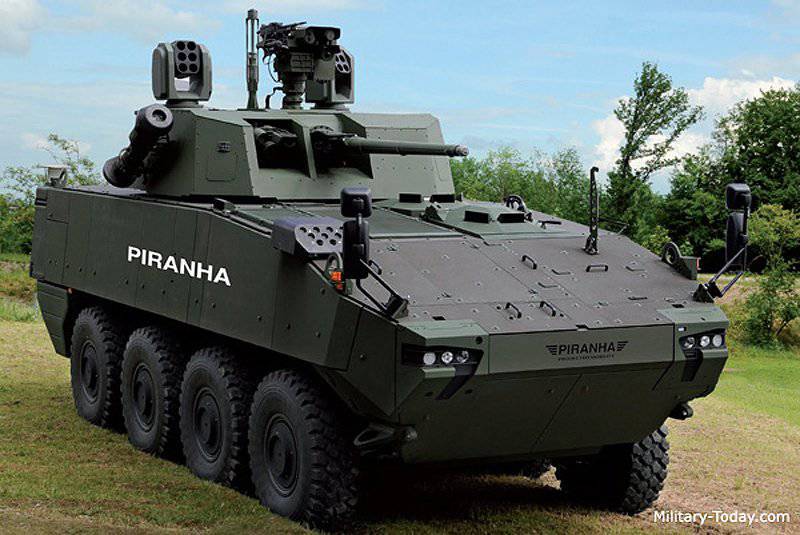
The first order system Rheinmetall SAS was the order for the Spanish Marines, where the system is integrated into the tower Lance, installed on the machine Piranha
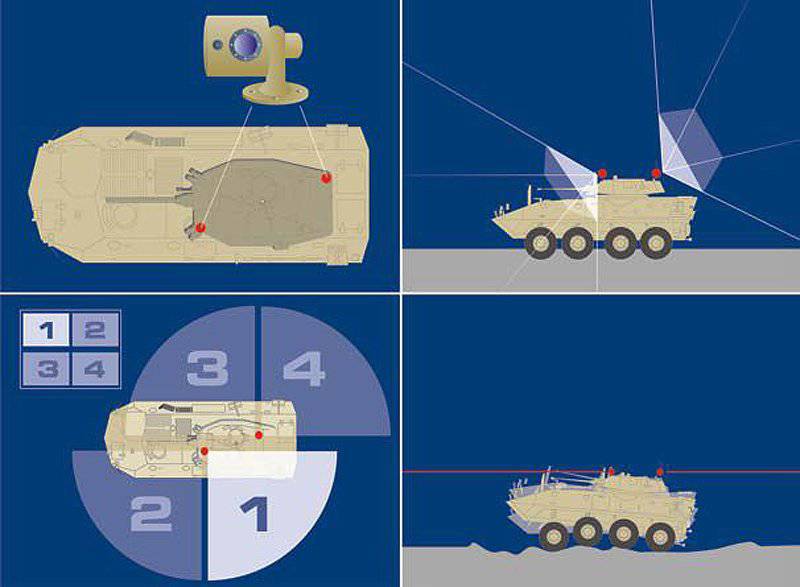
Application Diagram Zeiss Mini Sight on medium armored vehicle
System STA (See-Through Armor) from the Israeli company Elbit Systems provides seamless coverage 360 ° all-aspect of the external environment and the machine allows you to increase the selected image area. The system can support 4 to 12 day / night sensor with high resolution, providing vertical angles -20 ° / +30 °. Daytime sensors are in the form of cameras standard Gigabit Ethernet (common name data transmission technologies in the local network with 1 Gbit / s) available with different resolutions (640 x 480, 782 x 582 or 720 x 1280). For nighttime conditions imagers available uncooled bolometer-based sensor with a resolution of 384 x 288 or 640 x 480. Upgrading day and night channels usually estimated 25 frames per second Two-Frame delay, although with fluorescent sensors achievable maximum 100 frames / s. Captured images are processed STA algorithms that allows you to combine them into a single panoramic image 360 °. The image is then available for a maximum of three screens, where the operator can see the panoramic wheel selects an area of interest that it may increase while leaving, for example, the upper part of the screen for a panoramic view of the rear in order to maintain full awareness. STA can be integrated with other sensors, such as battle management systems, warning systems and fire control systems.
The company Carl Zeiss Optronics has recently developed a small stable platform Mini Sight System (MSS), which can take an uncooled thermal imager and / or CCD camera, and optional laser rangefinder. At MSS 250 mm diameter and 180 mm; Optics azimuthally rotated by 360 °, and the angle of elevation from -30 ° to +80 °. Stabilization biaxially ensures that the target remains in the field of view of MSS, the maximum angular velocity of 1.8 rad / s, while stabilizing the error of less than 300 millirad. MSS different motion detection algorithms, which reduces crew workload especially in urban environments. BMP installed two to three MSS to cover 360 °. Weight and dimensions of the system allow to establish a system for light armored vehicles of all types.
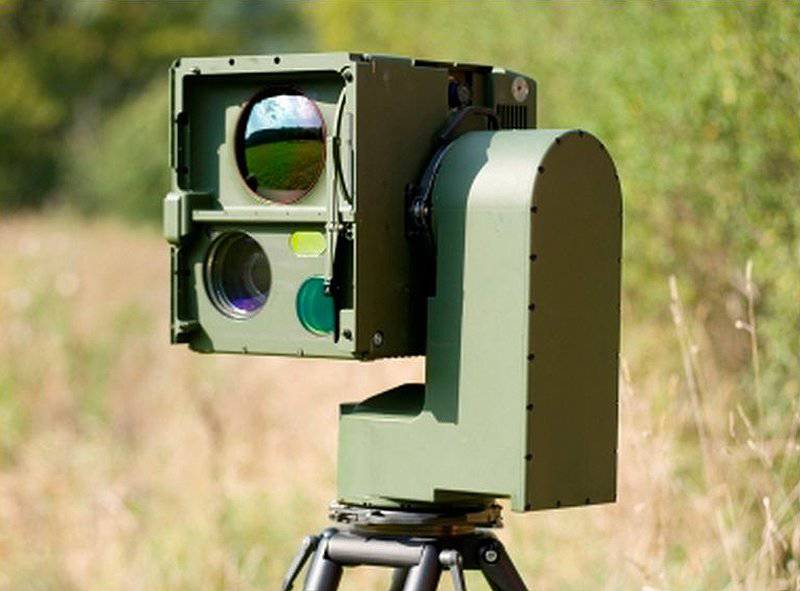
MiniSight, developed by Carl Zeiss Optronics, is a stable platform that can accept different types of sensors
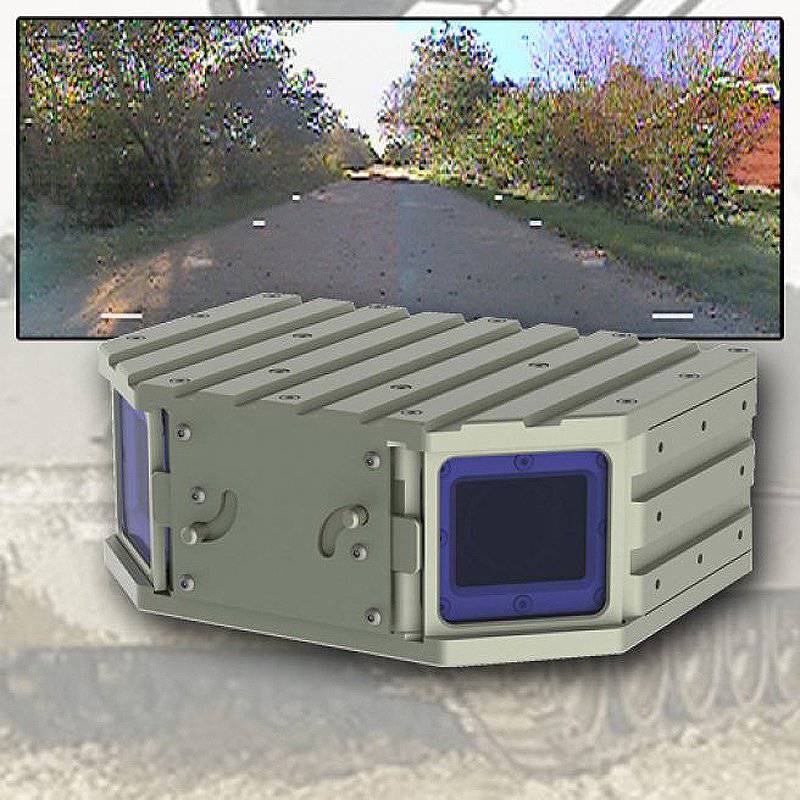
Panoramic version of the family of cameras CST «Citadel» includes two cameras, giving a single field of view of 170 °
Company Copenhagen Sensor Technology (CST) is developing a complete family of cameras situational awareness, which will be shown at the exhibition Eurosatory 2012. They are known under the designation Citadel and specially designed for installation on military platforms from light armored reconnaissance vehicles and tanks to. They are designed so that virtually no delay of the image; they can be used as an aid to the driver, giving him the advanced front and rear views, as well as all-round visibility for the commander and assault. Based on the latest generation of color CCD cameras, this system provides a clear high-resolution image in different conditions, from bright sunlight and to scenes with low lighting thanks to the work in the extended night mode. Fully hardened and having a low profile these cameras can operate in temperatures ranging from -40 ° C to +70 ° C. Citadel is a camera system in two basic configurations. Panoramic configuration consists of two chambers rugged metal housings. These chambers form the two video stream are "stitched" together in one stream with a horizontal field of view of 170 °. In the wide-angle configuration uses one wide field of view with the factory adjustment of the horizontal field of view of 47 ° to 112 ° depending on the specific model. Negotiation is through connector type MIL 38999, to provide easy connection to the onboard video processors and monitors. These cameras can easily be integrated into the modified system and the digital world for the newly developed machines CST company offers models with digital cameras Citadel interface Gigabit Ethernet, which provides high-speed streams of video data in accordance with either standard GigE Vision, or standard Def.Stan 00-82. The company closely communicates with the main European manufacturers of combat vehicles and systems integrators; several field trials are planned or are underway.
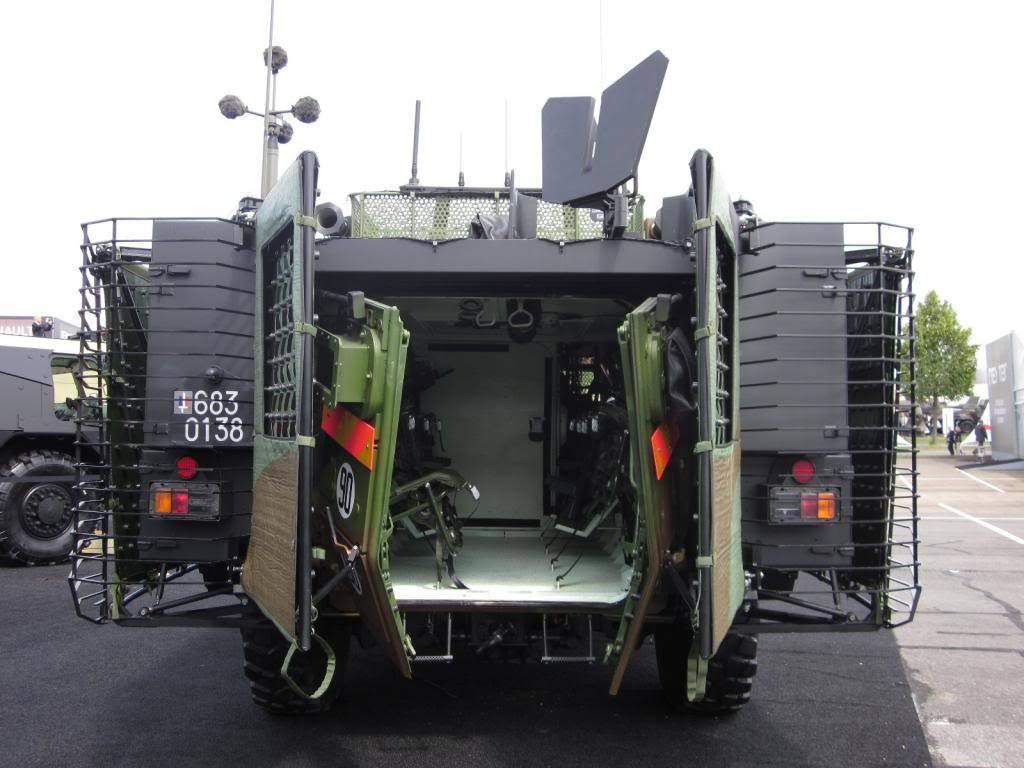
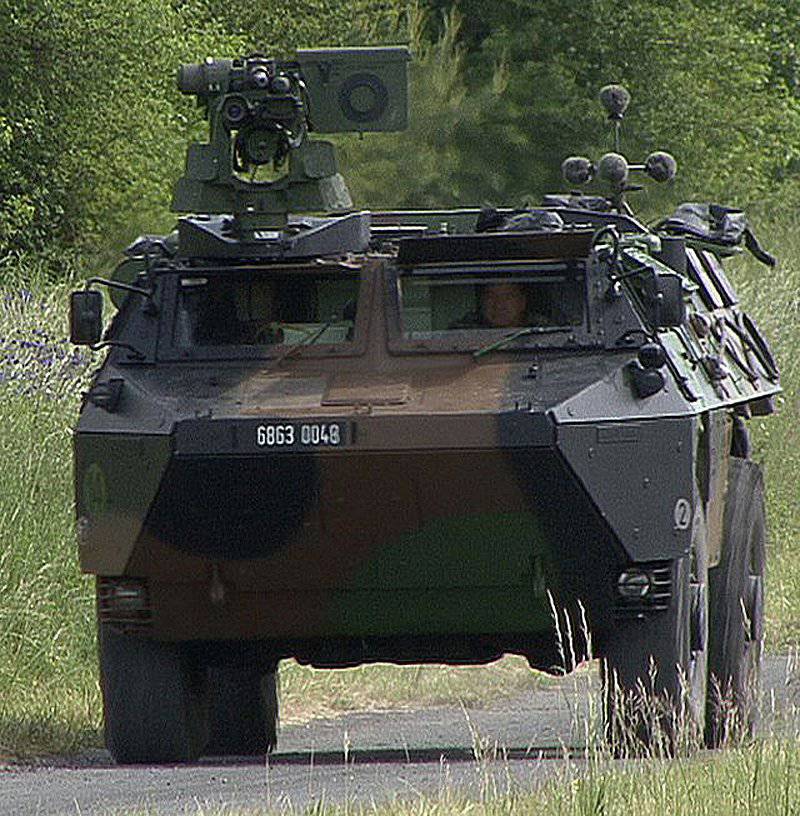
Last success speaker O1dB Metraviv Pilar held on upgraded machines 4x4 VAB TOP French contingent in Afghanistan
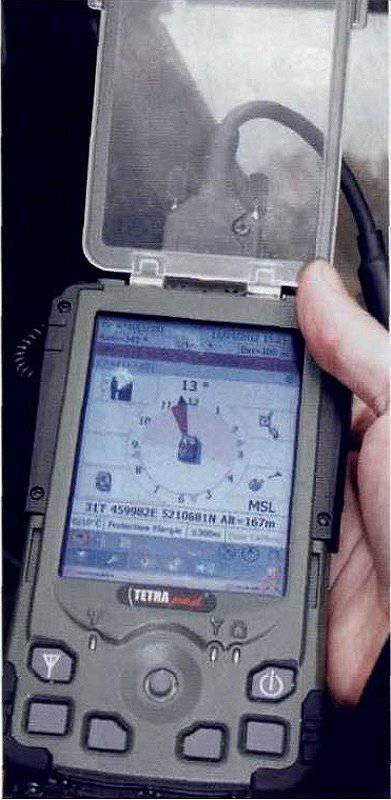
Human 01dB Metravib Pilar display shows the sector from which the threat
Speakers definition shots
While most of these systems is based on acoustic sensors, one of the newest developments is based on completely different principles on infrared focal plane technology. Known as the Flash (Fast as Light Assessment of Snipers and Hostile fire - rating the speed of light and enemy snipers) system produced by Hawaiian Oceanit. Infrared sensor - this chip, which operates at a frequency of more than 10,000 frames per second, can "see" the shot as it leaves the barrel and the bullet can communicate with a frequency of 1/10 second shot of the location and the type of weapon used, recognizing the rifle, RPG, etc. Flash is an all-sky cameras with lenses type fisheye. According to a statement Oceanit Flash system has a range of more than a kilometer from the detection probability of detecting more than 99% false positives and index of less than 0.1%. These characteristics are obtained by algorithms that allow to distinguish the flash of the gun and the flash reflected from shiny surfaces. Flash technology is used to develop HFDS (Hostile Fire Detection System - System definition of enemy fire) for the U.S. Army, which can be mounted on vehicles and helicopters. Unfortunately, this development is given very little information.
One of the most widely used acoustic detection systems is undoubtedly Raytheon BBN Technologies Boomerang III. At different levels deployed over 10,000 such systems. Latest contract from the U.S. Army was issued in October 2011 and includes both new systems and replacement parts. It operates at speeds up to 95 km / h and ensures detection of more than 95% of supersonic projectiles passing within 30 meters from the microphone mast. Precision azimuth and elevation over 2,5 °, and the error in range of ± 10%, the results are displayed in a half seconds. BBN does not disclose its customers, but the UK at least, is one of them, the system is integrated into the situational awareness system installed on most machines in Afghanistan.
To be continue,.........

SAS module on board the machine. System from Rheinmetall can have an
automatic target recognition
Ballistic threats, mines and roadside bombs faced by Western troops during the recent operations in Iraq and Afghanistan led to the adoption of machines and weapons systems that allow personnel to stay safe inside the armored capsule. On the one hand it ensures better protection, on the other degrades situational awareness (situational awareness of diverse information in a single space-time volume) crew. Something similar has already experienced soldiers of the infantry units.
The need to maintain or improve the level of situational awareness becomes even more important as the number of tasks performed in the urban environment, where the infantry is necessary to understand the situation before starting or feed ramp door. In this regard, many companies have developed optical-electronic systems that allow crews to get the maximum amount of visual information under the protection of armor. Can also be added to other sensory components such as system definition shots that not only warn personnel that their machine is under the gun, but also inform them about the direction and distance from which the shot occurred. Basically, situational awareness system trying to give crews that they could see and hear, if kept outside the machine head with the added benefit that can give advanced sensors.

the possible deployment of sensors Selex Galileo Road Marshall, including night view of the driver 50 °
 Situational Awareness: saving the lives of crews of vehicles
Situational Awareness: saving the lives of crews of vehiclesMachine Mastiff British army equipped with a system Selex Galileo Road Marshall. The company has delivered more than 1,200 systems to the British Ministry of Defence

Optoelectronic 360 °
Round visibility is the first parameter good review system of the vehicle, which itself depends on the network, collecting data and sending them to a processor, which in turn produces the image on the screens of the crew. Most of the widely accepted decisions based on a set of sensors placed around the car or around the chassis if the machine has a tower. Single sensors Omnidirection 360 ° also available in the market, they can be cheaper and easier to install. The problem consists in that quite often block the view of the machine elements, while odnosensornye systems have redundancy.
Company Selex Galileo has developed an integrated set of situational awareness for vehicle called Road Marshall, which includes a family of hardware, ranging from near-awareness and environment awareness far RSTA (recconnaissance, surveillance and target acquisition - intelligence, surveillance and target acquisition). The system - multi-function display, which is not only display, but also brings power to all connected systems and provides a link.
The standard model has a 10.4-inch display with a resolution of 1024x768 pixels, although the version with built-in computer with Windows XP is also available for third-party applications. These displays have a picture-in-picture mode, which is not available for smaller displays 8.4 inch crew. All sensors are connected to a single quick-release unit. For applications near surveillance company Selex Galileo uses its modules Night Vision System Driver (Driver Night Vision System), representing an uncooled thermal imager with a field of view of 52 ° x 38 °, working in the range of 8 - 12 microns. They can be supplemented with a day / night camera with a field of view of 90 ° x 75 ° and sensitivity from 0.009 to 100 lux. Configurations may vary from the driver's seat with a thermal camera and a screen to the system with a full circular cover 360 °; This system is able to handle up to 16 cameras. Each screen is an independent, soldiers can cause a desired image from one of the cameras. The company delivered more than 1,200 systems British Ministry of Defence. All protected Mastiff machine equipped with a 360 ° angle and have three screens: the driver, commander and assault.
The exhibition DSEI 2013 company Selex Galileo unveiled its new digital two-channel thermal / color camera DNVS-4 having two fields of view, respectively, 52 ° x 39 ° and 62 ° x 46,5 °. The output signal is a color video format (or Def Stan 00-82, or GigE Vision). The camera module can be added to cleaning windows. It is available only as a color or day / night camera with high performance, either as a monochrome camera for low light conditions. While previous analog version currently stands in service in Australasia, Europe and the Middle East, including Saudi Arabia, where it is installed on the BMP, the newest digital version has received an order from an unnamed European NATO member country. System Road Marshall from Selex Galileo has been integrated with the sound-detecting means firing positions: Britain chose Raytheon BBN Boomerang III, and other buyers system O1dB Metravib Pilar.
Over the past few years, Thales UK has put the UK around 100 analog systems situational awareness, but fully digital SI system was introduced in early 2011. Known under the designation of ILSA (Integrated Local Situational Awareness - integrated local situational awareness), the system includes a digital network with open architecture, as well as opto-electronic sensors and displays. However, the system is able to accept any sensor or display that is compatible with the new British design standards Def Stan 00-82 Digital Video Distribution and Def Stan 23-09 Generic Vehicle Architecture (GVA). The first contract was immediately obtained from the Force Protection Europe, on which the company Thales UK is responsible for all the electronic architecture Foxhound (armored vehicle under the trademark Ocelot, selected as part of the British requirements for light protected patrol car).

One of the newest products Selex Galileo - two-channel thermal / color camera DNVS-4

Thales VEM-2 RHS - this thermal sensor system ILSA, available with different fields of view
Thus, in early 2011, were ordered about 200 systems. ILSA ensures minimum latency and consists of two types of sensors, thermal cameras VEM-2 (W) and color / monochrome cameras, both small size weighing less than 2.5 kg. Thermal imaging cameras are in the range of 8 - 12 microns, have a horizontal field of view of 40 °, 50 ° and 90 ° and are based on the detector with a matrix of 640 x 480 pixels. The cameras have a horizontal field of view of 78 ° or 96 °, and can operate in low light down to 0.1 lux with 480 lines in color mode and 600 lines in monochrome mode, the sensor guarantees recognition of rights in the 100 meters. Images are sent to the central node, which distributes them to different displays "on demand", thus allowing, driver, commander and arrow, and a landing on their screens to see related images. ILSA system can accept other types of digital and analog sensors, for example, existing sights, remotely controlled weapon stations, speakers determine shot, even though the company has not asked for their integration. ILSA has also been selected for the program Scout SV, so the system is supplied by General Dynamics UK for the demonstration phase, after which will be produced from 400 to 600 machines. Configuration kit resembles the configuration adopted for the machine Foxhound. Sensors installed around the chassis, one of two screens for the landing is located on the aft bulkhead to the soldiers had a clear view of the situation behind the car. The company Thales UK is ready to incorporate new features into its ILSA, such as automatic target detection.
Situational awareness system SAS (Situational Awareness System) from the company Rheinmetall has coverage of 360 ° in its base configuration includes two modules, each consisting of three 60 ° camera (ie a total of 180 °) and video processing unit. The system can be adapted for all types of combat vehicles and expands up to 4 modules (day and infrared optics). Single images from the modules are sewn in the processing unit in the virtual panoramic image 360 °. The observer can select any portion of a panoramic view by simply touching the monitor. Likewise, you can choose the type of four windows; they all appear at the top of the monitor. In the extended version of the swap function is provided to support the counterattack measures. It is also possible to apply an automatic target detection and tracking; identified and tracked automatically presumed goals of viewing video inside, their data are extracted and reported to cyclically. The SAS System is serially produced, it was installed in the tower Lance, supplied by Rheinmetall in the Spanish Marines. Also, it must be tested at different chassis worldwide.

The first order system Rheinmetall SAS was the order for the Spanish Marines, where the system is integrated into the tower Lance, installed on the machine Piranha

Application Diagram Zeiss Mini Sight on medium armored vehicle
System STA (See-Through Armor) from the Israeli company Elbit Systems provides seamless coverage 360 ° all-aspect of the external environment and the machine allows you to increase the selected image area. The system can support 4 to 12 day / night sensor with high resolution, providing vertical angles -20 ° / +30 °. Daytime sensors are in the form of cameras standard Gigabit Ethernet (common name data transmission technologies in the local network with 1 Gbit / s) available with different resolutions (640 x 480, 782 x 582 or 720 x 1280). For nighttime conditions imagers available uncooled bolometer-based sensor with a resolution of 384 x 288 or 640 x 480. Upgrading day and night channels usually estimated 25 frames per second Two-Frame delay, although with fluorescent sensors achievable maximum 100 frames / s. Captured images are processed STA algorithms that allows you to combine them into a single panoramic image 360 °. The image is then available for a maximum of three screens, where the operator can see the panoramic wheel selects an area of interest that it may increase while leaving, for example, the upper part of the screen for a panoramic view of the rear in order to maintain full awareness. STA can be integrated with other sensors, such as battle management systems, warning systems and fire control systems.
The company Carl Zeiss Optronics has recently developed a small stable platform Mini Sight System (MSS), which can take an uncooled thermal imager and / or CCD camera, and optional laser rangefinder. At MSS 250 mm diameter and 180 mm; Optics azimuthally rotated by 360 °, and the angle of elevation from -30 ° to +80 °. Stabilization biaxially ensures that the target remains in the field of view of MSS, the maximum angular velocity of 1.8 rad / s, while stabilizing the error of less than 300 millirad. MSS different motion detection algorithms, which reduces crew workload especially in urban environments. BMP installed two to three MSS to cover 360 °. Weight and dimensions of the system allow to establish a system for light armored vehicles of all types.

MiniSight, developed by Carl Zeiss Optronics, is a stable platform that can accept different types of sensors

Panoramic version of the family of cameras CST «Citadel» includes two cameras, giving a single field of view of 170 °
Company Copenhagen Sensor Technology (CST) is developing a complete family of cameras situational awareness, which will be shown at the exhibition Eurosatory 2012. They are known under the designation Citadel and specially designed for installation on military platforms from light armored reconnaissance vehicles and tanks to. They are designed so that virtually no delay of the image; they can be used as an aid to the driver, giving him the advanced front and rear views, as well as all-round visibility for the commander and assault. Based on the latest generation of color CCD cameras, this system provides a clear high-resolution image in different conditions, from bright sunlight and to scenes with low lighting thanks to the work in the extended night mode. Fully hardened and having a low profile these cameras can operate in temperatures ranging from -40 ° C to +70 ° C. Citadel is a camera system in two basic configurations. Panoramic configuration consists of two chambers rugged metal housings. These chambers form the two video stream are "stitched" together in one stream with a horizontal field of view of 170 °. In the wide-angle configuration uses one wide field of view with the factory adjustment of the horizontal field of view of 47 ° to 112 ° depending on the specific model. Negotiation is through connector type MIL 38999, to provide easy connection to the onboard video processors and monitors. These cameras can easily be integrated into the modified system and the digital world for the newly developed machines CST company offers models with digital cameras Citadel interface Gigabit Ethernet, which provides high-speed streams of video data in accordance with either standard GigE Vision, or standard Def.Stan 00-82. The company closely communicates with the main European manufacturers of combat vehicles and systems integrators; several field trials are planned or are underway.


Last success speaker O1dB Metraviv Pilar held on upgraded machines 4x4 VAB TOP French contingent in Afghanistan

Human 01dB Metravib Pilar display shows the sector from which the threat
Speakers definition shots
While most of these systems is based on acoustic sensors, one of the newest developments is based on completely different principles on infrared focal plane technology. Known as the Flash (Fast as Light Assessment of Snipers and Hostile fire - rating the speed of light and enemy snipers) system produced by Hawaiian Oceanit. Infrared sensor - this chip, which operates at a frequency of more than 10,000 frames per second, can "see" the shot as it leaves the barrel and the bullet can communicate with a frequency of 1/10 second shot of the location and the type of weapon used, recognizing the rifle, RPG, etc. Flash is an all-sky cameras with lenses type fisheye. According to a statement Oceanit Flash system has a range of more than a kilometer from the detection probability of detecting more than 99% false positives and index of less than 0.1%. These characteristics are obtained by algorithms that allow to distinguish the flash of the gun and the flash reflected from shiny surfaces. Flash technology is used to develop HFDS (Hostile Fire Detection System - System definition of enemy fire) for the U.S. Army, which can be mounted on vehicles and helicopters. Unfortunately, this development is given very little information.
One of the most widely used acoustic detection systems is undoubtedly Raytheon BBN Technologies Boomerang III. At different levels deployed over 10,000 such systems. Latest contract from the U.S. Army was issued in October 2011 and includes both new systems and replacement parts. It operates at speeds up to 95 km / h and ensures detection of more than 95% of supersonic projectiles passing within 30 meters from the microphone mast. Precision azimuth and elevation over 2,5 °, and the error in range of ± 10%, the results are displayed in a half seconds. BBN does not disclose its customers, but the UK at least, is one of them, the system is integrated into the situational awareness system installed on most machines in Afghanistan.
To be continue,.........
Diubah oleh boleroes11 15-04-2014 22:08
0
4.7K
7
Thread Digembok
Urutan
Terbaru
Terlama
Thread Digembok
Komunitas Pilihan